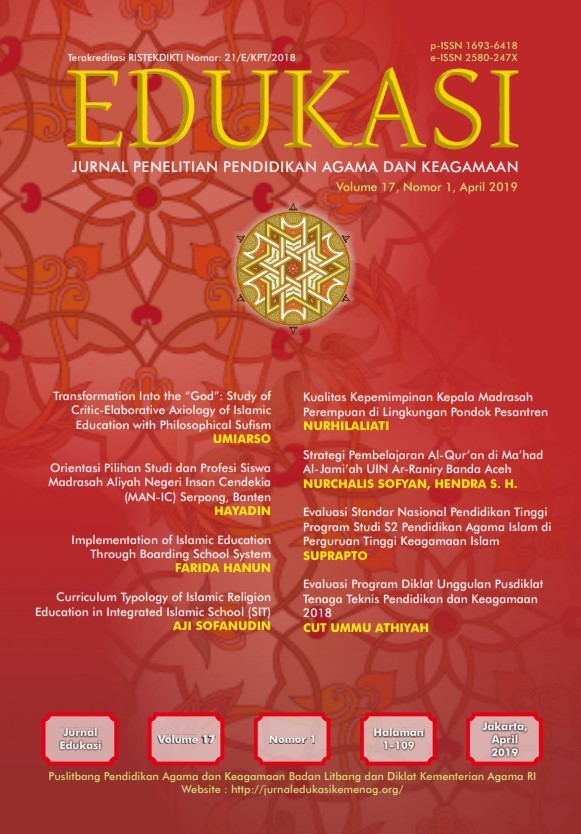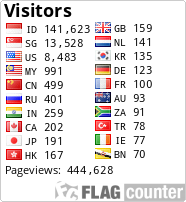ORIENTASI PILIHAN STUDI DAN PROFESI SISWA MADRASAH ALIYAH NEGERI INSAN CENDEKIA (MAN-IC) SERPONG, BANTEN
DOI:
https://doi.org/10.32729/edukasi.v17i1.564Keywords:
Decision making, options, profession orientation, studi orientation, Insan cendekia, Orientasi studi, Pengambilan keputusan, Pilihan profesiAbstract
Abstract
This study aims to determine the orientation of education of students of Madrasah Aliyah Negeri Insan Cendekia (MAN-IC) Serpong, after graduation. As it refers to the national education system, students who graduate from secondary education have a chance to go to higher education, whether academic, profession or vocational path. This was a case study toward student future orientation. Data sources came from head school, tachers, psychologists, counselors, school committee, documents, and students. Data and information were collected by observation, interview, discussion and questionaire. The results showed that students prefer academic path rather than professional and vocational paths. The majority of learners choose domestic high schools, and some choose overseas, and few choose Islamic high schools and Ma'ahad Aly. The majority (85%) of them felt confident with the choice of study, and 75% were already convinced by their choice of profession. Those who were still in doubt, was caused by economic variable as they doubt whether they can fund the study finance or not, ,and also by the awareness of the dynamic changing environment. From the side of profession, majority of them tent to become academics, lecturers, researchers, and inventors; and some choose to be merchants or entrepreneurs.
Abstrak
Penelitian ini bertujuan untuk mengetahui orientasi dan motivasi pendidikan siswa-siswi Madrasah Aliyah Negeri Insan Cendekia (MAN-IC) Serpong, setelah tamat. Sebagaimana merujuk pada sistem pendidikan nasional, bahwa peserta didik yang tamat jenjang pendidikan menengah, berkesempatan untuk lanjut pada jenjang pendidikan tinggi, baik yang bersifat akademik, profesi ataupun vokasi. Ini adalah penelitian studi kasus yang fokus kepada peserta didik. Sumber data berasal dari pimpinan, ustaz, psikolog, konselor, pembina asrama, dokumen, serta para peserta didik. Data dan informasi dikumpulkan dengan cara observasi, wawancara, dan diskusi serta kuesioner. Hasil penelitian menunjukan bahwa para siswa lebih memilih jalur akademik ketimbang jalur profesi dan vokasi. Mayoritas peserta didik memilih Perguruan Tinggi Umum (PTU) dalam negeri, dan beberapa memiilih PT luar negeri, serta sedikit yang memilih Perguruan Tinggi Keagamaan Islam (PTKI) dan Ma’had Aly. Mayoritas (85%) mereka merasa yakin dengan pilihan studi, dan 75% yang sudah yakin dengan pilihan profesinya. Mereka yang masih ragu, disebabkan oleh variabel dana pendidikan yang belum pasti sumbernya, dan adanya kesadaran terhadap lingkungan yang dinamis dan berubah cepat. Dari sisi pilihan profesi, mayoritas (tapi kurang dari setengahnya) cenderung memilih menjadi akademisi, dosen, peneliti, dan inventor; sebagian kecil memilih untuk menjadi pedagang atau entrepreneur.References
Ball, B. (2012) A summary of motivation theories. Available at: https://www.your coach.be/en/employee-Â-motivation-Â-ebook/https://www.yourcoach.be/en/employee-Â-motivation-Â-ebook/ (Accessed: 11 February 2019).
Burgess, S. et al. (2009) What Parents Want: School preferences and school choice. 09. Bristol. Available at: https://www.bristol.ac.uk/cmpo/Tel: (Accessed: 11 February 2019).
Cendekia, M. I. (2006) Sejarah Insan Cendekia dan BJ Habibe. Available at: https://manicserpong.com/sejarah-insan-cendekia-dan-bj-habibe/ (Accessed: 14 November 2017).
Djojonegoro, W. (2016) Sepanjang Jalan Kenangan. 1st edn. Edited by A. Makmur Makka and Eka Suryana. Jakarta: Kepustakaan Populer Gramedia. Available at: https://play.google.com/books/reader?id=RCdIDwAAQBAJ&hl=en&pg=GBS.PA263 (Accessed: 10 February 2019).
Dotson, R. (2016) ‘Goal Setting to Increase Student Academic Performance’, Journal of School Administration Research and Development Summer, 1, p. 44. Available at: https://www.jsard. org/wp-content/uploads/2016/03/Goal-Setting.pdf (Accessed: 11 February 2019).
Hastings, J. S. et al. (2007) Preferences, Information, and Parental Choice Behavior in Public School Choice. Available at: https://justinehastings.com/ wp-content/uploads/2016/12/Hastings VanWeeldenWeinstein_InfoChoice.pdf (Accessed: 11 February 2019).
Indonesia, S. (2003) UU No. 20 tahun 2003, tentang Sistem Pendidikan Nasional. Indonesia.
McClelland, D. . (1987) Human Motivation. New York: Cambridge University Press.
Nurmi, J.-E. (1991) ‘REVIEW How Do Adolescents See Their Future? A Review of the Development of Future Orientation and Planning’, 59, pp. 1–59. Available at: https://ac-els-cdn-com.ez.sun.ac.za/0273229791900026/1-s2.0-0273229791900026-main.pdf?_tid=98b5999b-3092-4fa3-8e5d-205aa25e69b1&acdnat=1550938090_fba3866543318380bdcf6d943a53056f.
Rahmat (2014) ‘Madrasah sebagai Lembaga Pendidikan Islam (Sistem dan Perkembangannya Sebelum dan Sesudah kemerdekaan)’, Jurnal Rihlah, I(2), pp. 53–68.
Seginer, R. (2008) ‘Future orientation in times of threat and challenge: How resilient adolescents construct their future’, International Journal of Behavioral Development, 32(4), pp. 272–282. doi: 10.1177/0165025408090970.
Serpong, M. I. (2017) Profil MAN-IC Serpong, Panitia Penerimaan Siswa Baru 2017. Available at: http;//www.ic.sch.id/december2016/profil-manicserpong.html (Accessed: 23 September 2017).
Tanaka, A. (2018) ‘Keharusan Memajukan Madrasah’, Jurnal Teknologi Pendidikan Madrasah, 1(2), pp. 164–174. doi: 10.5281/zenodo.1419735.
Taufik, O. A. (2013) ‘Determinasi madrasah efektif’, Jurnal Universitas Pendidikan Indonesia, 01(01), pp. 01-13.
Trommsdorff, G. (1983) ‘Future Orientation and Socialization’, International Journal of Psychology, 18(1–4), pp. 381–406. doi: 10.1080/00207598308247489.
Webley, P. and Nyhus, E. K. (2006) ‘Parents’ influence on children’s future orientation and saving’, Journal of Economic Psychology. doi: 10.1016/j.joep.2005.06.016.
Whitehurst, G. J. and Whitfield, S. (2013) School Choice and School Performance in the New York City Public Schools-Will the Past be Prologue? Available at: https://www.brookings.edu/wp-content/uploads/2016/06/School-Choice-and-School-Performance-in-NYC-Public-Schools.pdf (Accessed: 11 February 2019).
Witanti, F. N. (2016) ‘Revitalisasi Madrasah sebagai Lembaga Pendidikan Integratif - Alternatif’, Tarbiyatuna, 7(2), pp. 186–204.
Downloads
Published
Issue
Section
License
Copyright Notice
Authors who publish with this journal agree to the following terms:
- Authors retain copyright and grant the journal right of first publication with the work simultaneously licensed under a Creative Commons Attribution License that allows others to share the work with an acknowledgement of the work's authorship and initial publication in this journal.
- Authors are able to enter into separate, additional contractual arrangements for the non-exclusive distribution of the journal's published version of the work (e.g., post it to an institutional repository or publish it in a book), with an acknowledgement of its initial publication in this journal.
- Authors are permitted and encouraged to post their work online (e.g., in institutional repositories or on their website) prior to and during the submission process, as it can lead to productive exchanges, as well as earlier and greater citation of published work (See The Effect of Open Access).
EDUKASI Â have CC-BY-SA or an equivalent license as the optimal license for the publication, distribution, use, and reuse of scholarly work.
In developing strategy and setting priorities, EDUKASI Â recognize that free access is better than priced access, libre access is better than free access, and libre under CC-BY-SA or the equivalent is better than libre under more restrictive open licenses. We should achieve what we can when we can. We should not delay achieving free in order to achieve libre, and we should not stop with free when we can achieve libre.
 EDUKASI  is licensed under a Creative Commons Attribution 3.0 International License
You are free to:
- Share — copy and redistribute the material in any medium or format
- Adapt — remix, transform, and build upon the material for any purpose, even commercially.
- The licensor cannot revoke these freedoms as long as you follow the license terms.










